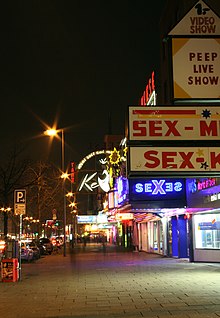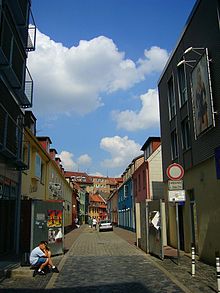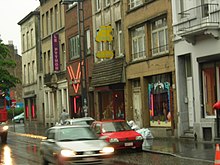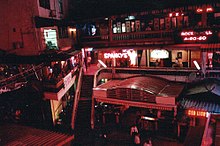Red light district
A red light district (in Switzerland: red light district ) is an area of a city in which prostitution and other types of sex trade are concentrated. The associated social environment is the red light district .
The term red light district is usually used negatively. See also red light (prostitution) .
Origin of the term
The English term red-light district was formed around 1900, but as early as 1850 there were a number of brothels on Greene Street in Manhattan (now SoHo), above whose entrances gas lights burned in red (but also differently colored) glass balls. In German, the terms red light district and red light district did not appear until the early 1920s. This term ( Italian quartiere a luci rosse , Dutch rosse buurt ) documents that a kind of “ ghettoization ” of the brothel and prostitute milieu has taken place in many cities . A similar term in Japanese is akasen . The term “red light district” is usually associated with criminal behavior ( e.g. drug trafficking , human trafficking , blackmail ).
Origin and structure
A neighborhood doesn't usually become a red light district because there are some brothels there. Only a certain number or variety of businesses in the sex industry turn a quarter of a city into a red light district. The spectrum of offers can range from prostitution on the street or in brothels to sex shops and striptease bars or table dance bars to porn cinemas and entertainment bars .
The emergence of red light districts is promoted by a number of social factors. Guests of the facilities of the red light district are often interested in the local proximity of the various facilities so that they can easily change location on foot during the entertainment phase, for example from a table dance bar to an entertainment venue and from there to a brothel.
In the area of a red light district, there is also a lower risk of meeting people who neither belong to the red light district nor are interested in it. Many users find it embarrassing, for example, after visiting an exposed sex shop, to feel looked at in a wrong way when entering the street.
The character of a red light district often depends on whether there is a curfew , i.e. a legal restriction on business activities at night , or not. Above all, this has an impact on whether the relevant bar operations can be found, from which the majority of active life in a red light district may originate. Especially in red-light districts with no curfew there are also entertainment establishments that do not belong to the red-light district, such as bars, restaurants, amusement arcades, theaters, cabarets and the like.
Special features of the German red light district
Due to the comparatively liberal legal situation in Germany - for example the recognition of prostitution as a profession - red light districts have a less hidden and more open structure than in many other countries. The balance of power in German red-light districts has changed fundamentally in recent years, as has generally been the case in the red-light district.
backgrounds
The emergence of red-light districts in Germany was decisively promoted by restricted area ordinances ; in other words, through municipal or urban ordinances that only permitted prostitution to be carried out outside of a certain area, usually the inner city , such as in Frankfurt am Main. A red light district was often created in the immediate vicinity of a street . This development was also favored by the fact that other typical facilities, such as sex shops, were also only permitted in certain areas for planning and building purposes.
In cities such as Berlin , which do not have restricted area regulations, a concentration on red light districts can only be observed to a limited extent. In Berlin, for example, the areas around Oranienburger Strasse or Stuttgarter Platz (“Stutti”) that can be described as red light districts do not play a dominant role in relation to the overall activities of the Berlin red light district .
Housing value
The quality of living in a red-light district is generally considered to be low. This is not only due to the noise at night, or the environment, which usually has a rather poor social infrastructure. Red light districts are also often dangerous places where violent crimes and property crimes are increasing . The environment is therefore considered unsuitable for children and young people.
State control
The massing of facilities of the red light district in red light districts allows for easier state control. Commercial law requirements can be checked, for example, as part of a supervisory patrol in a large number of facilities. The concentrated deployment of police forces on site ensures a minimum of security with a manageable amount of personnel. A prominent example is the Hamburg middle of the red light district of St. Pauli located Davidwache , a municipal police station.
An example of the construction of a red light district for control reasons is Helenenstrasse in Bremen .
Administrative offense law
According to Section 120, Paragraph 1, No. of the Law on Administrative Offenses (OWiG), an administrative offense exists if prostitution is carried out in an area prohibited by statutory order . According to the wording of Section 120 (1) No. 2 OWiG, it is also forbidden to offer, announce, advertise or announce the opportunity to sexual acts in return for payment or to make declarations of such content. In the opinion of the Federal Court of Justice , however, this does not mean that advertising for prostitution is generally prohibited. Rather, there must be a concrete impairment of the general public, for example the protection of minors .
Well-known red light district
Germany
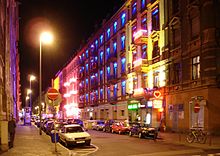
- An example of a red light district that is known worldwide is the Reeperbahn in Hamburg - St. Pauli with its adjacent streets. Here in particular Herbertstraße and the area around Hans-Albers-Platz (also called Kiez or Meile ).
- In Berlin is Oranienburgerstraße a popular address. While this has achieved a certain level of awareness and acceptance among locals and tourists as the red light mile, conflicts between the mostly Eastern European prostitutes and the residents occur time and again in Kurfürstenstrasse (Berlin-Tiergarten) . The area around Stuttgarter Platz ( Stutti ) was also known as the red light district.
- In Hanover , the Steintorviertel is a well-known red light mile.
- In Nuremberg , the old town quarter around the Frauentormauer between Spittler- and Färbertor, as well as Ottostraße and Engelhardsgasse, represents the central red light district. First sources indicate that prostitution in women's shelters has been practiced since 1381 . In the 19th century the houses were often referred to as wine shops.
- In Frankfurt am Main , Kaiserstraße has become a synonym for the Frankfurt red light district for many people , although it is outside the tolerance zone for prostitution. The surrounding station district was especially popular with the American GIs after the Second World War . The actual red light district, however, is mainly concentrated in the area of the northern station district between Taunusstrasse and Niddastrasse.
- In the Ruhr area , the Bochum red light district on Gussstahlstrasse is known under the names "Gurke" and "Eierberg" . Something similar can be found in Essen ( Stahlstraße ), Duisburg ( Vulkanstraße ), Oberhausen ( Flaßhofstraße ) and Dortmund ( Linienstraße ).
- In Flensburg , especially in the 20th century, the Oluf-Samson-Gang (with the adjoining Kaysers-Hof complex ) was probably the best-known “mile of sin” between Hamburg-St. Pauli and the Copenhagen Istedgade .
- In Kiel , the street Wall am Hafen is a well-known red light district.
- In the Bruchstraße in Braunschweig is a bitch settled in spite of a decision taken in 1594 ban.
- In Aachen , Antoniusstraße is the city's central red light district.
- In Mannheim , Lupinenstraße is the red light district.
- In Karlsruhe , the brothels are concentrated in Brunnenstrasse.
More Europe
- The red light district of Walletjes in Amsterdam was one of the first areas in the world where prostitutes were allowed to legally work and organize.
- The former Parisian red light district Pigalle on Montmartre with the famous Moulin Rouge and the area around Rue Saint-Denis are world famous.
- In the UK u. a. the train station area around King's Cross in London .
- In Vienna , in the course of the amusement park around the Prater, the red light district developed in the so-called Stuwerviertel triangle, which is separated from Lassallestrasse , Expositionstrasse and Vorgartenstrasse ; in the more recent past, however, areas of the belt and Felberstrasse have been far better known and more frequented red light areas.
- In Zurich , the milieu is located around Langstrasse ( district 4 and 5 ).
- In Geneva , the red light district can be found in the Les Pâquis area, especially on Rue de Berne.
- The Copenhagen Istedgade applies for their entertainment and red light district as one of the most famous streets in the country.
- In Dublin the Monto existed .
- In Brussels , Rue d'Aerschot is one of several streets in the city with prostitution options.
Outside of Europe
- The Patpong streets (as well as Nana Plaza ) in Bangkok are among the internationally best known red light districts.
- The best-known red light districts of Tokyo are Kabukichō in Shinjuku District and what was formerly known as Yoshiwara in Senzoku District.
- The Kings Cross train station district in Sydney is also a red light district.
- Part of Avenida Revolución in Tijuana , Mexico , is a Mexican red-light district on the border with the United States that is mostly used by Americans.
See also
Web links
Individual evidence
- ^ Irving Lewis Allen: The City in Slang: New York Life and Popular Speech (1995), p. 178.
- ↑ Zeitschrift für Sexualwissenschaft , Volume 7 (1920), edited by A. Marcus & E. Weber; Report of an investigation into Detroit Red Light District prostitutes for syphilis and gonorrhea infections .
- ↑ Wilhelm Heinrich Dreuw, Moritz Schönmann: The Sexual Revolution (1921), S. 366 (Definition Red Light District )
- ^ BGH, judgment of July 13, 2006 (I ZR 231/03) .
- ↑ Franz Michael Rohm: How the Stuttgarter Platz has shed its dirty image. In: Morgenpost.de. Berliner Morgenpost , September 6, 2016, accessed on February 15, 2019 .
- ↑ Thoben : Prostitution . In: Michael Diefenbacher , Rudolf Endres (Hrsg.): Stadtlexikon Nürnberg . 2nd, improved edition. W. Tümmels Verlag, Nuremberg 2000, ISBN 3-921590-69-8 ( complete edition online ).
